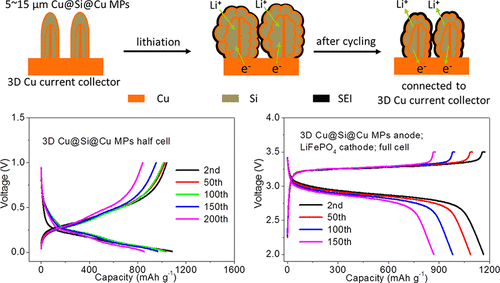Our official English website, www.x-mol.net, welcomes your
feedback! (Note: you will need to create a separate account there.)
Multishelled [email protected] Microparticles Supported on 3D Cu Current Collectors for Stable and Binder-free Anodes of Lithium-Ion Batteries
ACS Nano ( IF 15.8 ) Pub Date : 2018-04-09 00:00:00 , DOI: 10.1021/acsnano.8b00703 Zailei Zhang 1, 2, 3 , Zhong Lin Wang 1, 2, 3, 4 , Xianmao Lu 1, 2, 3
ACS Nano ( IF 15.8 ) Pub Date : 2018-04-09 00:00:00 , DOI: 10.1021/acsnano.8b00703 Zailei Zhang 1, 2, 3 , Zhong Lin Wang 1, 2, 3, 4 , Xianmao Lu 1, 2, 3
Affiliation

|
Silicon has proved to be a promising anode material of high-specific capacity for the next-generation lithium ion batteries (LIBs). However, during repeated discharge/charge cycles, Si-based electrodes, especially those in microscale size, pulverize and lose electrical contact with the current collectors due to large volume expansion. Here, we introduce a general method to synthesize [email protected] (M = Si, Al, C, SiO2, Si3N4, Ag, Ti, Ta, SnIn2O5, Au, V, Nb, W, Mg, Fe, Ni, Sn, ZnO, TiN, Al2O3, HfO2, and TiO2) core–shell nanowire arrays on Cu substrates. The resulting [email protected] nanowire arrays were employed as LIB anodes that can be reused via HCl etching and H2-reduction. Multishelled [email protected]@Cu microparticles supported on 3D Cu current collectors were further prepared as stable and binder-free LIB anodes. This 3D [email protected]@Cu structure allows the interior conductive Cu network to effectively accommodate the volume expansion of the electrode and facilitates the contact between the [email protected]@Cu particles and the current collectors during the repeated insertion/extraction of lithium ions. As a result, the 3D [email protected]@Cu microparticles at a high Si-loading of 1.08 mg/cm2 showed a capacity retention of 81% after 200 cycles. In addition, charging tests of 3D [email protected]@Cu-LiFePO4 full cells by a triboelectric nanogenerator with a pulsed current demonstrated that LIBs with silicon anodes can effectively store energy delivered by mechanical energy harvesters.
中文翻译:

3D铜集电器上支持的多壳[受电子邮件保护]微粒,用于稳定和无粘结剂的锂离子电池阳极
事实证明,硅是下一代锂离子电池(LIB)具有高比容量的有前途的负极材料。然而,在重复的放电/充电循环期间,由于大的体积膨胀,硅基电极,特别是那些微尺度尺寸的硅基电极,会粉碎并且失去与集电器的电接触。在这里,我们介绍一种合成[受电子邮件保护]的通用方法(M = Si,Al,C,SiO 2,Si 3 N 4,Ag,Ti,Ta,SnIn 2 O 5,Au,V,Nb,W,Mg ,Fe,Ni,Sn,ZnO,TiN,Al 2 O 3,HfO 2和TiO 2)铜基板上的核-壳纳米线阵列。所得的[受电子邮件保护的]纳米线阵列用作LIB阳极,可通过HCl蚀刻和H 2还原再利用。进一步制备了负载在3D Cu集电器上的多壳[电子邮件保护] @Cu微粒,将其制成稳定且不含粘结剂的LIB阳极。这种3D [受电子邮件保护] @Cu结构允许内部导电Cu网络有效地容纳电极的体积膨胀,并在重复插入/提取锂离子期间促进[受电子邮件保护] @Cu颗粒与集电器之间的接触。 。结果,在1.08 mg / cm 2的高Si负载下3D [受电子邮件保护] @Cu微粒在200个循环后显示出81%的容量保持率。此外,通过摩擦电纳米发电机在脉冲电流的作用下对3D Cu-LiFePO 4的3D [email protected] @ Cu-LiFePO 4电池进行充电测试,结果表明,带有硅阳极的LIB可以有效地存储机械能收集器提供的能量。
更新日期:2018-04-09
中文翻译:

3D铜集电器上支持的多壳[受电子邮件保护]微粒,用于稳定和无粘结剂的锂离子电池阳极
事实证明,硅是下一代锂离子电池(LIB)具有高比容量的有前途的负极材料。然而,在重复的放电/充电循环期间,由于大的体积膨胀,硅基电极,特别是那些微尺度尺寸的硅基电极,会粉碎并且失去与集电器的电接触。在这里,我们介绍一种合成[受电子邮件保护]的通用方法(M = Si,Al,C,SiO 2,Si 3 N 4,Ag,Ti,Ta,SnIn 2 O 5,Au,V,Nb,W,Mg ,Fe,Ni,Sn,ZnO,TiN,Al 2 O 3,HfO 2和TiO 2)铜基板上的核-壳纳米线阵列。所得的[受电子邮件保护的]纳米线阵列用作LIB阳极,可通过HCl蚀刻和H 2还原再利用。进一步制备了负载在3D Cu集电器上的多壳[电子邮件保护] @Cu微粒,将其制成稳定且不含粘结剂的LIB阳极。这种3D [受电子邮件保护] @Cu结构允许内部导电Cu网络有效地容纳电极的体积膨胀,并在重复插入/提取锂离子期间促进[受电子邮件保护] @Cu颗粒与集电器之间的接触。 。结果,在1.08 mg / cm 2的高Si负载下3D [受电子邮件保护] @Cu微粒在200个循环后显示出81%的容量保持率。此外,通过摩擦电纳米发电机在脉冲电流的作用下对3D Cu-LiFePO 4的3D [email protected] @ Cu-LiFePO 4电池进行充电测试,结果表明,带有硅阳极的LIB可以有效地存储机械能收集器提供的能量。















































 京公网安备 11010802027423号
京公网安备 11010802027423号